Text : Katie
Photographs : Internet
Heat! Sweltering, muggy heat and no respite; sweaty, sticky and sun-burnt is the fate of the Mumbaikar for most of the year. Respite comes only from air-conditioning. So one remains cooped up in a room, terrified to step outdoors. To beat the high temperatures of the city, we headed northwards into the Himalayas; our destination – Sikkim in the northeast of India. In retrospect, the choice of our first stop in Sikkim, makes me smile. City folk must head to another city! So, Gangtok, the capital city of Sikkim is where we began our sojourn.
The land of exotic flora and fauna
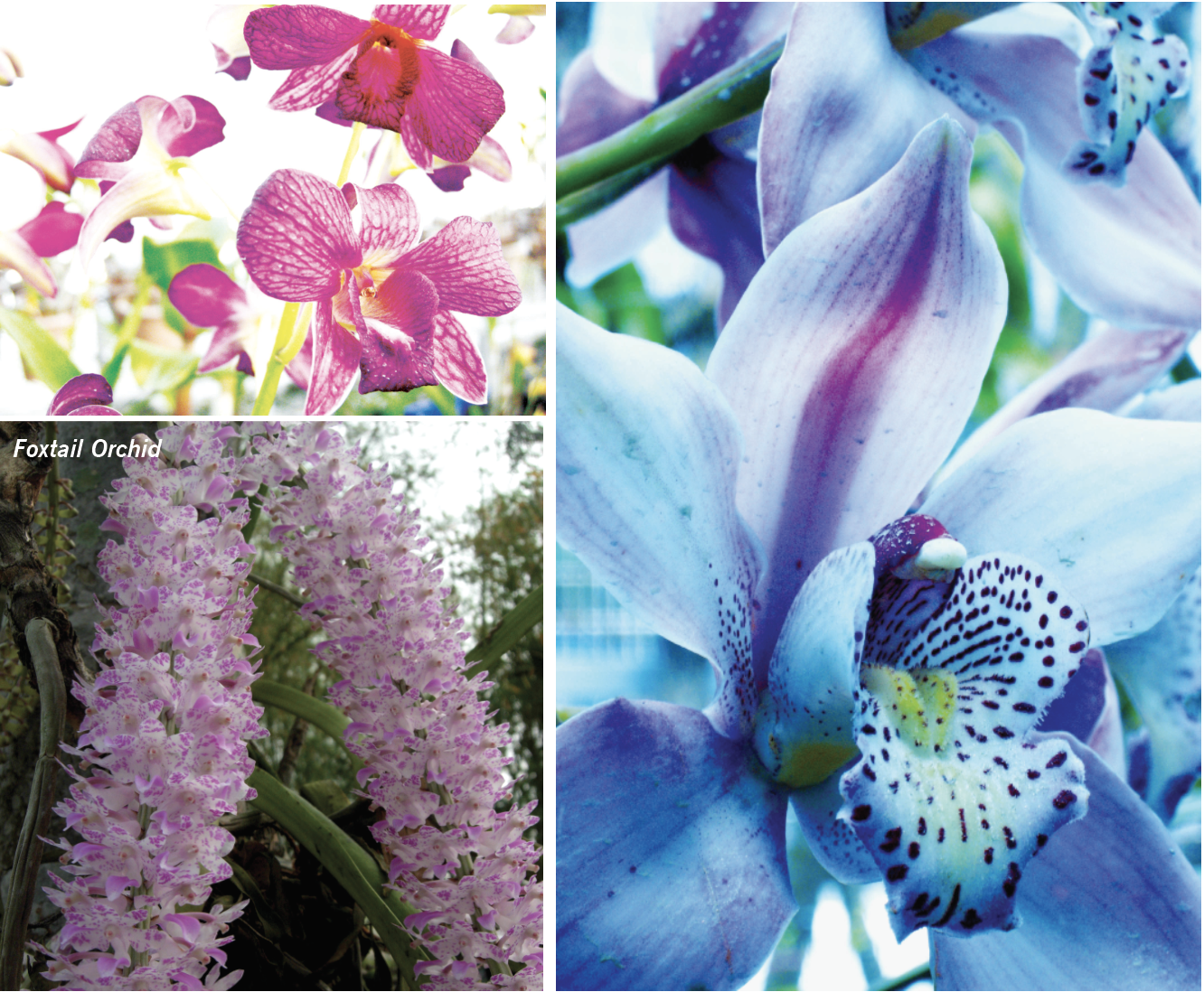
A part of the Eastern Middle Himalayas, Sikkim is a small mountain state with an area of 7,096 square kilometers, at an elevation of 28,169 square feet. Altitude and topographical variations that occur from the mountain base to its summits, foster unique flora and fauna. It hosts over 4000 plant species of which 523 are orchids. Moreover, 22 species of orchids are endemic to the state. Among the 574 bird species, ten of the eastern Himalayan species are native to Sikkim and of the total seventeen are threatened. Its lush and diverse vegetation includes both the alpine and the sub-tropical and this in turn is the home of an exotic variety of fauna; the snow leopard, red panda, musk deer, blue sheep and the Shapi, a rare mountain goat with a long white mane also belongs here and is an endangered animal as well. Almost thirty-five percent of the state is covered by the Kanchenjunga National Park, a biosphere reserve. In July 2016, UNESCO declared it as the first Mixed Heritage Site of India and it owes name to the mountain – Kanchenjunga which it surrounds.
Kanchenjunga is the third highest mountain in the world with an elevation of 28,169 feet.
The change from the chaotic traffic and noise of Mumbai to the cool and equally chaotic, clogged roads of Gangtok is not all that much. Shops line the narrow roads with people weaving in and out of motor traffic, cars and buses parked along the very edge of the precipice had made my heart lurch and remains and indelible sight. When a traffic jam occurred, as it often did along those ribbon roads, the driver peaceably turned off the car engine and relaxed, unfazed.
The city of Gangtok
Gangtok, means hill cut and this is evident. Gangtok has been cut into the hillside, along the western side of a long ridge flanking the Ranipul river. Its origins are that of a hamlet, but with the building of the Enchey Monastery it became a Buddhist pilgrimage centre. The monastery was first built in the 1840s by the eighth Chogyal at the exact location where Lama Druptub Karbo had his hermitage. However, what is seen now was re-built in 1909, imitating a Chinese Pagoda and is one of two in Gangtok.
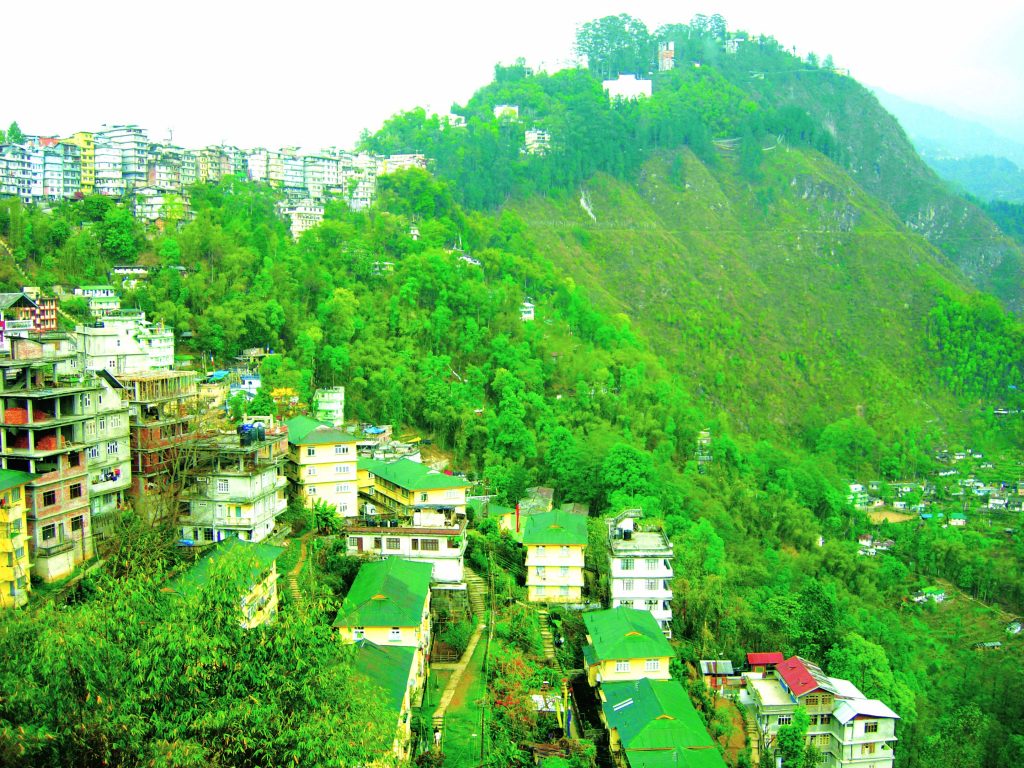
In 1894, The Sikkimese monarch who was under British protectorate changed the capital from Tumlong to Gangtok. It became the capital of what was left of Sikkim after an English conquest in the mid nineteenth century. After the defeat of the Tibetans by the British, Gangtok became a major stopover on the trade route between Tibet and British India. Following Indian Independence in 1947, Sikkim became a nation-state under the suzerainty of India, with the condition that it would retain its independence, according to the treaty signed between the Chogyal and the then Indian Prime Minister Jawaharlal Nehru. In 1975, after years of political uncertainty and struggle, including riots, the monarchy was abrogated and Sikkim became India’s twenty-second state.

Like every other hill city, Gangtok has grown by leaps and bounds in an ad hoc manner, trying to keep up with the modernism of the world. The city that began with single storied dwellings integrated into the pine covered slopes, now has seven to eight storey structures mushrooming all over its slopes. To add insult to injury, the new buildings are painted in the most startling colours – garish shades of indigo blue, dazzling yellow or chalky green, that is jarring and completely incongruous with the surrounding mountainside, which offers stunningly beautiful views. Asthetics apart, there is a lot on offer in this mountain city with its narrow roads dipping up and down steep slopes, over which the Sikkimese race both ways with light steps. We decided to limit our exploration of the city to the relatively flat Mall Road and the mall itself, reminiscent of the British who once occupied this land and rooted their culture here as well. The Sikkimese have preserved it as a pedestrian zone. Brightly lit shops with a variety of wares and multi-cuisine hotels line both sides of the road. One can stroll along unhindered. Sitting on the street bench, we watch the ladies, traditionally attired in their Khos moving gracefully around.
A spectacular view of the Kangchenjunga
Next morning we moved higher up into the mountains to a little known destination – Pelling. Leaving Gangtok at 10 a.m., we had motored over slender, curvaceous roads and reached our destination at 3 p.m.
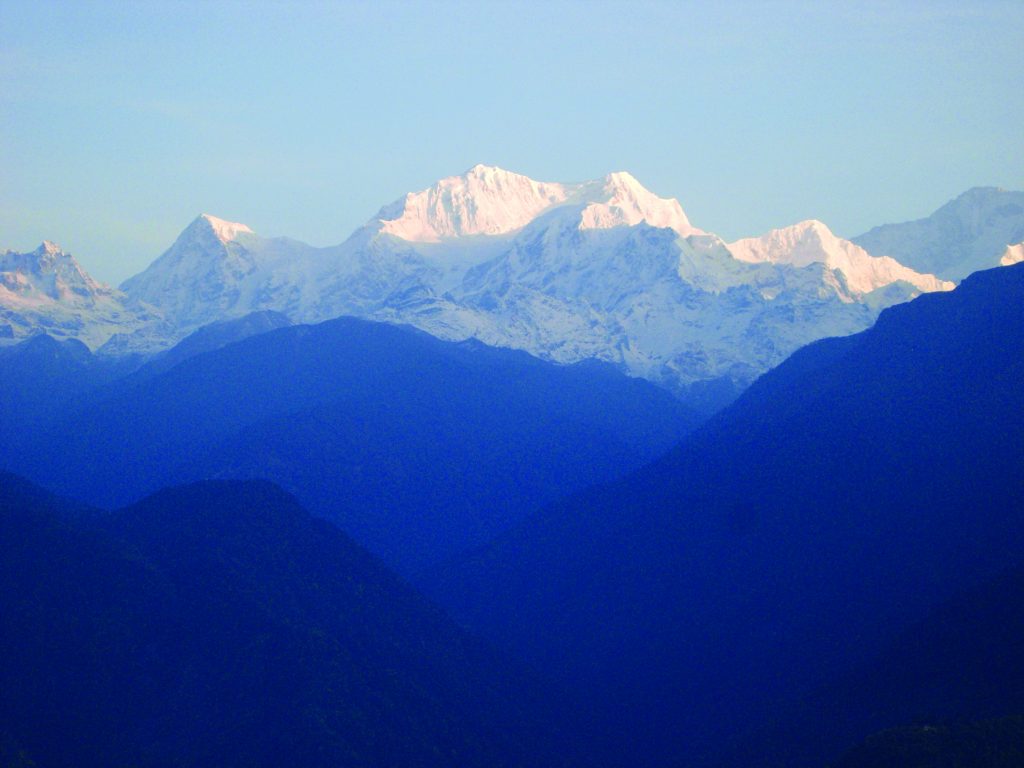
A buffeting Himalayan wind had engulfed us as we had alighted from the warm comfort of our jeep, pricking my half-clad arms with icy spikes. Hugging myself for warmth, I had dashed through the entrance door of the hotel. In the dimly lit lobby of the hotel, I had felt better, but, stunned by the chill, had remained shivering by the doorway. Suddenly, a little fellow had materialised. Bending forward correctly and formally, one hand behind his back, a tray balanced in the other, he had offered, “Ma`m, welcome drink, Cherry Brandy”. My face must have betrayed me and my hand shot out for the glass, for the waiter’s mouth had cracked into a smile, dimpling his cheeks. Then, we were escorted to our room. Immediately, its wide window had attracted us like a magnet. Framed perfectly within its square had been a panorama that kept us glued to the spot. The Khangchenjunga, crowned with snow, stood before us in all its majesty.
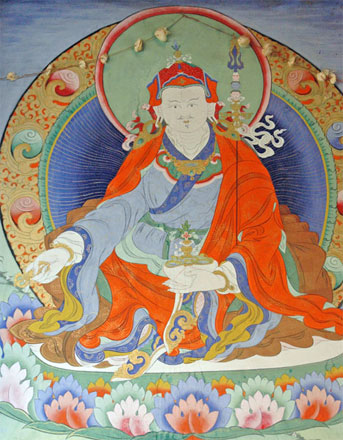
Wrenching ourselves away from the window view had been difficult. We had then decided to drive to Yuksom, forty kilometers from Pelling. Wending down the slim mountainous road with its treacherous curves and hair-pin bends our driver had kept the pace slow, obeying the sign on the road that said ‘Be gentle on my curves’. (Local drivers fortunately leave their egos at home, being responsible for the lives of the passengers and their own.) The sky was already overcast and a thin drizzle had begun to leak through the clouds, adding sheen and sparkle to the dense vegetation that covered every inch of the steep slopes that rose laterally along the inner side of the road. I had realised with a jolt that on the outer road-edge we were motoring along the line of tree tops; nothing could be glimpsed of the drop below! My heart had thumped a distress signal. It would have been a very short cut to a green heaven, if the car skidded off the road! Concentrating on the happier aspect of the journey, I had noticed that cardamom plants formed dense clumps. Here and there would appear some plantains, great clumps of bamboo, gigantic ferns and numerous other plants in multitudinous shades of green. Interspersed among these were the delicate whites of orchids, dangling shyly from the forks of mossy trees, wild daisies and other dainty little flowers that had found some space in the crevices of the road wall and stood out sharply. We stopped ecstatically to photograph, trying the patience of our driver who, simply could not understand our obsession to click pictures of one flower after another in multiples. Midway, it was a waterfall, winking mischievously in the sun that halted us, its source- a pin point a few hundred feet above us. The stream rappelled down, jumping on to large boulders in steps and finally smashing itself into a small holding pool at the base of the slope with a shower of sparkles. Shedding inhibitions, I had removed my shoes and waded into the pool of cold water. Childish delight! Splashing and yelping in the icy water, ignoring remonstrations, I had cupped the crystal liquid and taken a few gulps of this manna from heaven, before we moved on.
The sacred landscape of Yuksom
Yuksom, is perhaps better known for its connection with the Bollywood star of yesteryears, Danny Dengzongpa, than for its history. Along its main street the only major structure was that of a hotel belonging to Danny. The rest were simply shacks or makeshift tents beneath which locals spread out their wares, mostly clothes and shoes that came across the border from China. Yuksom means “meeting place of the three learned monks” and its monastery Dubdhi, is a landmark in Sikkimese history. Legend states that three monks from Tibet converged here to select Phuntsog Namgyal as the firsrt King of Sikkim, giving him the title ‘Chogyal’– “the king who rules with righteousness” and crowned him king in 1641. Yuksom is part of a sacred landscape consisting of four religious sites that have been blessed by Guru Padmasambhava and which are supposed to be the four plexuses of the human body. Yuksom represents the ‘third eye’. Yuksom, became the first capital of Sikkim. Dubdhi monastery was built later in 1701 an hour’s trek away from Yuksom, deep in the forest. Of the thirty to forty monks once housed here just a few remain. It still holds valuable paintings and manuscripts along with the statues of the three lamas who anointed the first Chogyal. Half a century later, the capital shifted to Rabdantse near Pelling, but Yuksom is still a revered site.

Pelling, at 6800 ft. is remote. Even in the 21st century it is just one street with single storey homes and now, a few hotels coming up. Pelling draws people today because it stands face to face with the patron Goddess of Sikkim – Kanchengjunga. Perhaps, in the remote past, that would have been exactly what would have propelled the king to have his summer palace here. Today, the palace is a heritage hotel, the only one with a frontal view of the high Himalayan range.
Kangchenjunga means the “Five Treasures of Snow,” and refers to Kangchenjunga’s five snow clad peaks. It holds tremendous religious significance for the Sikkamese and hence no one has ever been allowed to put a foot on its summit. The climbers who got close to the peak in 1955, halted way beneath the summit, honouring the promise given to the Chogyal.
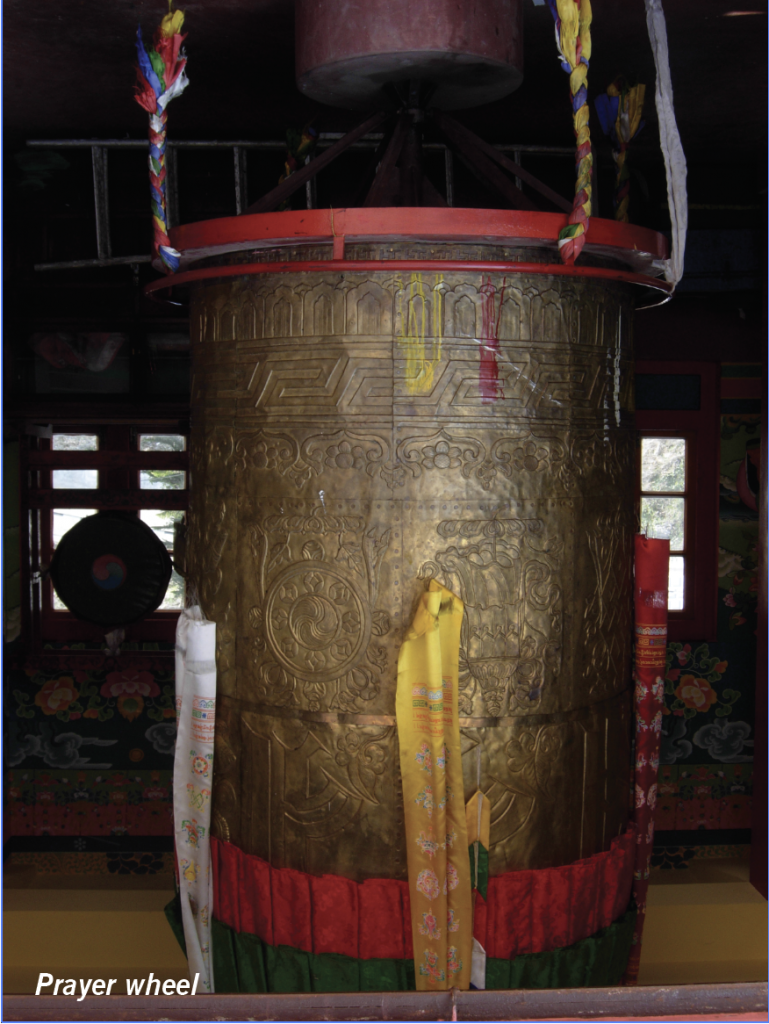
The alarm shrilled insistently at 4 a.m. I jumped out of the bed and groggily ran to the window drawing the curtains apart. A thick curtain of cloud greeted me. The high Himalayas were shrouded. “Get up” I urged my partner, “people have already gathered in the garden”. “Oh, the keen types”, he quipped. “Is it clear?” he asked. “Not yet”. I kept anxious vigil by the window open to the frigid morning air. 4.30 a.m. Anxiety struck my heart. If the clouds did not roll away, sunrise on the peaks, for which we had traversed hundred and thirty-five kilometers, would be lost. My prayers were answered. A minute or two later, a solitary peak loomed above the clouds. The piercing rays of the rising sun shredded the cloud curtain. Enclosed perfectly within our window-frame, close enough to touch, stood some of the highest mountain peaks of the world, draped in dazzling white snow. The distinctive pyramidal shape of the Kangchenjunga towered above the others around it. 5 a.m. The light got a bit stronger and out of a pale grey-blue sky, a pencil thin beam of golden light shot out. It beamed straight on to the pyramidal peak, torching it into a gold-dusted beacon. By the minute, the light spread rapidly moving along the range, torching each peak in turn like a taper put to candles and they flared up radiantly, blushing mildly. The scene in front of us was ethereal, awesome and enchanting. Our cameras clicked frenetically. We were watching the rapidly changing scene through the lens only, in single pointed concentration, aware that this was a never to be repeated show. We tried to capture every millisecond of this dramatic moment conscious that it would soon be over and sure enough it was in the next few minutes, as the sun climbed higher.
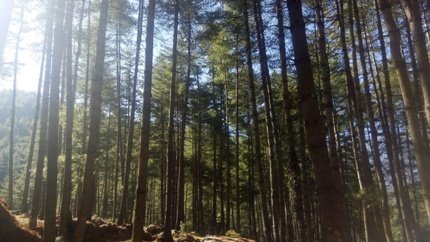
All good things must end.
We turned our attention to our next destination, Pemayangtse Gompa or monastery, a short distance from our hotel, which is the second oldest monastery of Sikkim founded in 1705. Pemayangtse too, stands aloof on a hilltop ringed protectively by the mountains it venerates. As we entered the courtyard we heard the sound of chanting from within the hall, the sound floating melodiously on the crisp air and saw the customary prayer flags, attached to a pole flutter in the whispering wind. We waited patiently until the monks had finished their ritual and only then did we enter. To the left of the stairs is housed a large prayer wheel in its own enclosure. Buddhists first put the prayer wheel in motion to release the efficacy of the mantras written on it and only then enter the monastery.

Pemayangtse is a three-storied wooden structure. The main prayer hall on the ground level holds a massive statue of the Buddha flanked by his other incarnations and teachers of the sect. Butter lamps, in deep brass bowls are kept burning in a row at their lotus feet. The walls have painted mandalas, one for each of the gurus of Buddhism. The first floor has more idols of the stalwarts of Buddhism, glass-encased and massive. The hall is empty and serene. On the third floor is a unique floor to ceiling structure the ‘Sanghthokpalri’ a seven tiered painted structure the Heavenly Palace of Guru Rimpoche that encompasses all that is on earth and ascends to heaven. Fascinated, I had silently saluted the monk who had given five years of his life to this single handed creation as a measure of his devotion. Then, I descended to the main hall, the Lakhang. The vibrations were sublime. I sat quietly on a low bench facing the Buddha, absorbing the peace He bestowed. After a while, I heard my name being called out. The world had prevailed and I left the monastery to re-join it.


 [/column]
[/column]